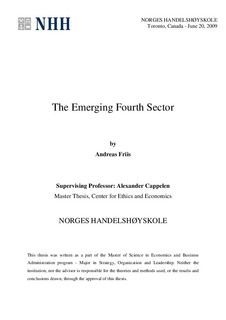| dc.description.abstract | The Fourth Sector is a new phenomenon related to dual social and financial value creation,
until now not clearly defined with crisp sectoral boundaries and an operationalized definition.
The phenomenon is getting increased attention in media, conferences, business schools and
by organizations all over the world, and this study intends to explain the macroenvironmental
changes that led to the rise of the fourth sector, describe new trends of social
value creation in the private sector and financial value creation in the nonprofit sector – and
thereby also find that there is a convergence of sectors towards a new hybrid intersection of
dual social and financial value creation – sometimes referred to as the fourth sector. The
existing definitions will be critizied, and the fourth sector will be redefined with a new, more
operationalized definition.
In addition, a strategic analysis of two fourth sector companies – Me to We Style and God El
– will be conducted. This analysis will focus specifically on the internal analysis of these
companies, analyzing whether the fourth sector business model leads to any competitive
advantages/disadvantages. All other things will be isolated from this analysis, and an external
analysis will not be relevant here, since the fourth sector business model will not influence
the external competitive environment in these cases. Relevant findings are indications that
fourth sector companies (here defined by God El and Me to We Style) can have competitive
advantages in their fourth sector business model, in their customer relations, in their
employee relations and especially in their relationships with their suppliers and other
alliances, where they are able to really leverage the business model, saving cost for the
company. It is unclear whether access to capital might become a competitive disadvantage for
fourth sector companies over time – it is not for these two fourth sector start-ups analyzed
here. | en |
